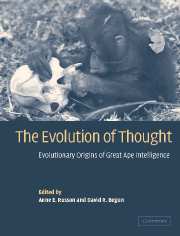Book contents
- Frontmatter
- Contents
- List of Contributors
- Preface
- 1 Evolutionary reconstructions of great ape intelligence
- 2 Enhanced cognitive capacity as a contingent fact of hominid phylogeny
- PART I COGNITION IN LIVING GREAT APES
- PART II MODERN GREAT APE ADAPTATION
- Introduction
- 7 What's in a brain? The question of a distinctive brain anatomy in great apes
- 8 Life histories and the evolution of large brain size in great apes
- 9 Evolution of complex feeding techniques in primates: is this the origin of great ape intelligence?
- 10 The special demands of great ape locomotion and posture
- 11 Great ape social systems
- 12 Diet and foraging of the great apes: ecological constraints on their social organizations and implications for their divergence
- PART III FOSSIL GREAT APE ADAPTATIONS
- Part IV INTEGRATION
- Author index
- Species index
- Subject index
10 - The special demands of great ape locomotion and posture
Published online by Cambridge University Press: 20 August 2009
- Frontmatter
- Contents
- List of Contributors
- Preface
- 1 Evolutionary reconstructions of great ape intelligence
- 2 Enhanced cognitive capacity as a contingent fact of hominid phylogeny
- PART I COGNITION IN LIVING GREAT APES
- PART II MODERN GREAT APE ADAPTATION
- Introduction
- 7 What's in a brain? The question of a distinctive brain anatomy in great apes
- 8 Life histories and the evolution of large brain size in great apes
- 9 Evolution of complex feeding techniques in primates: is this the origin of great ape intelligence?
- 10 The special demands of great ape locomotion and posture
- 11 Great ape social systems
- 12 Diet and foraging of the great apes: ecological constraints on their social organizations and implications for their divergence
- PART III FOSSIL GREAT APE ADAPTATIONS
- Part IV INTEGRATION
- Author index
- Species index
- Subject index
Summary
INTRODUCTION
Amidst the welter of competencies that could be labeled “intelligence,” the great apes repeatedly demonstrate numerous high–level abilities that distinguish them from other mammals and ally them with humans (Griffin 1982; Parker & Gibson 1990; Russon, Bard & Parker 1996; Suddendorf & Whiten 2001). Self-concept is argued to be among this set of distinctive abilities. It is often viewed as an integral aspect of advanced intelligence, one that some have argued allows great apes to have a theory of mind (Heyes 1998 and references therein). Among the abilities that co-occur with it in humans are symbolic play, simple altruism, reciprocal relationships, a concept of planning, and pleasure in completion of complex tasks (Povinelli & Cant 1995).
Until recently, the demands of locomotion and posture, together referred to as positional behavior (Prost 1965), were not explicitly considered to correlate with any aspect of primate intelligence or its evolution, self-concept included. Primate intelligence is most often hypothesized to have evolved either for negotiating complex social problems, or for mapping and resolving complicated foraging challenges (for an overview, see Russon, Chapter 1, this volume). Chevalier-Skolnikoff, Galdikas and Skolnikoff (1982: 650) suggested instead that, at least for orangutans, locomotor demands were “the single major function for which the advanced cognitive abilities … evolved.” Povinelli and Cant (1995) subsequently refined and expanded this hypothesis, asserting that self-concept in orangutans evolved to enable these large-bodied apes to negotiate thin, compliant (i.e., flexible) branches during suspensory locomotor bouts, particularly when crossing gaps in the canopy.
- Type
- Chapter
- Information
- The Evolution of ThoughtEvolutionary Origins of Great Ape Intelligence, pp. 172 - 189Publisher: Cambridge University PressPrint publication year: 2004
- 21
- Cited by



